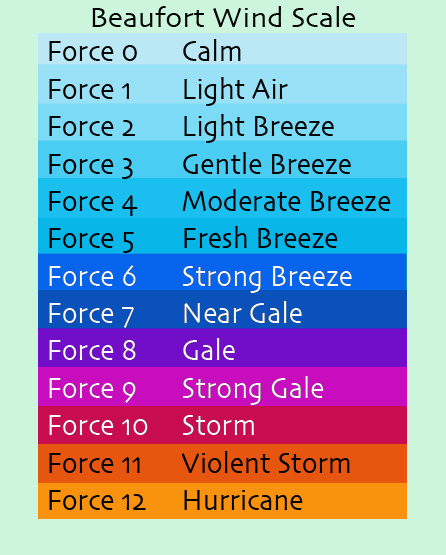|
Subject: D10) Why do hurricane force winds start at 64 knots ? Contributed by Neal Dorst (HRD)
During the 19th Century, with the manufacture of accurate anemometers, actual numerical values were assigned to each Force level, but it wasn't until 1926 (with revisions in 1939 and 1946) that the International Meteorological Committee (predecessor of the WMO) adopted a universal scale of wind speed values. Since the scale was originally nautical in nature, and that most wind reports at that time were in nautical miles per hour (or converted to them), these numerical values were given in knots. It was a progressive scale with the range of speed for Forces increasing as you go higher. Thus Force 1 is only 3 knots in range (1 kt - 3 kt), while the Force 11 is eight knots (56 kt - 63 kt) in range. So Force 12 [Hurricane] starts out at 64 knots (74 mph, 33 m/s). There is nothing magical in this number, and since hurricane force winds are a rare experience, chances are the committee which decided on this number didn't do so because of any real observations during a hurricane. Indeed, the Smeaton-Rouse wind scale in 1759 pegged hurricane force at 70 knots (80 mph, 36 m/s). Just the same, when a tropical cyclone has maximum winds of approximately these speeds we do see the mature structure (eye, eyewall, spiral rainbands) begin to form, so there is some utility with setting hurricane force in this neighborhood. References
Last updated August 13, 2004 Back to Tropical Cyclones Winds Page | Back to Main FAQ Page |
TC FAQ
Links of Interest
AOML Tools & Resources
Employee Tools
|
 In 1805-06, Commander Francis Beaufort RN (later Admiral Sir Francis
Beaufort) devised a descriptive wind scale in an effort to standardize
wind reports in ship's logs. His scale divided wind speeds into
14 Forces (soon after pared down to thirteen) with each
Force assigned a number, a common name, and a description of the
effects such a wind would have on a sailing ship. And since the
worst storm an Atlantic sailor was likely to run into was a hurricane,
that name was applied to the top Force on the scale.
In 1805-06, Commander Francis Beaufort RN (later Admiral Sir Francis
Beaufort) devised a descriptive wind scale in an effort to standardize
wind reports in ship's logs. His scale divided wind speeds into
14 Forces (soon after pared down to thirteen) with each
Force assigned a number, a common name, and a description of the
effects such a wind would have on a sailing ship. And since the
worst storm an Atlantic sailor was likely to run into was a hurricane,
that name was applied to the top Force on the scale.
